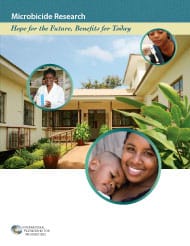Microbicide Research: Providing Benefits Today

IPM’s mission not only gives families hope for a healthier future by working to reverse the HIV epidemic, but also advances broader global development goals.
Microbicide development involves many steps to test and introduce a new product, and requires years of sustained involvement by a large number of researchers, community health workers and clinical trial volunteers.
Research efforts both strengthen clinical research capacity in the areas hardest hit by the HIV epidemic and benefit the people and communities that host clinical trials.
Strengthening medical research capacity
In recent years, growing concern has focused on the fact that only about 10 percent of global medical research spending is focused on the health problems in developing countries that carry about 90 percent of the world’s health burden.
To help eliminate what is called the “10/90” research gap, it is essential to increase medical research capacity in countries where disease prevention and health-improving products are most urgently needed.
Microbicide research strengthens medical research capacity in developing countries by:
- building capabilities in geographic areas of greatest need for HIV prevention
- increasing and developing physical infrastructure and human resources at research centers
- enhancing the understanding of epidemic trends through HIV incidence/prevalence studies
- strengthening the capability to conduct ethical, high-quality clinical trials
- building the foundation to get new medical products approved for use
Benefiting communities
Nonprofit product developers like IPM carefully design clinical trials to ensure the greatest benefit for the people, communities and countries that host them. This includes making sure the trials are conducted according to the most rigorous ethical standards.
Microbicide research also benefits the communities that host clinical trials by:
- promoting HIV and overall health awareness
- improving access to HIV care services and health care generally
- empowering women through education and counseling
- involving men in HIV prevention
- encouraging HIV testing
- engaging communities in future HIV/AIDS advocacy
- providing employment and professional development opportunities in communities
With the support of its community partners, IPM has completed or initiated many research studies, among them clinical trials, HIV incidence/prevalence studies and product acceptability studies.
